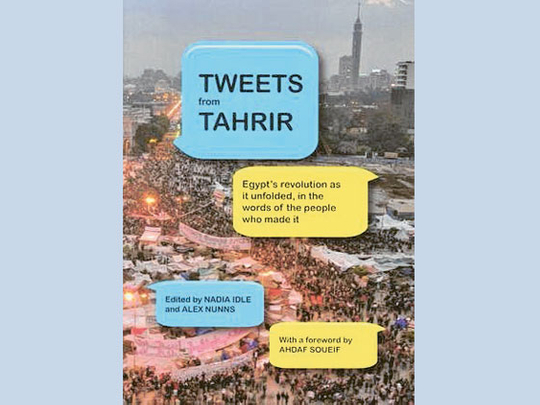
There is only so much you can say in 140 characters; but nowhere were so few words used to such great effect as those of the Egyptian revolution via Twitter.
In a new social networking phenomenon, the microblogging site was used to rally Egyptian citizens, organise protests, stand up against a hated regime and send out information despite internet cuts enforced by the state last January and February.
Twitter became a constant feed of information, updating Egypt and the rest of the world about the progress of the revolution.
Published in a new format, these all-telling 140-character tweets have been compiled in the book Tweets From Tahrir: Egypt's Revolution As It Unfolded, in the Words of the People Who Made It, by Bloomsbury Qatar Foundation Publishing.
Edited by Alex Nunns and Nadia Idle — an Egyptian who was in Tahrir Square when former president Hosni Mubarak fell — Tweets From Tahrir has been called "a record of great courage" by veteran journalist Robert Fisk.
The 21 chapters tell the story of the Egyptian revolution through the eyes of Cairo-based tweeters, including Google's Middle East head of marketing Wael Ghonim, who became a public face of the revolution after being detained by the government for his part in the uprising.
Although the editors admit the revolution was not just Cairo-based in the book's introduction, it would be impossible to print every tweet from every city in Egypt.
One tweeter wrote 60,000 words during the revolution, they write in the introduction. In the book, tweets have been reproduced in their original format, without corrections to grammatical or spelling mistakes.
Arabic words are also transliterated in many different ways and have not been adjusted in the volume for consistency.
Tweets are reproduced in the book with the users' pictures, Twitter name, real name and the date and time of the Tweet — to the exact second.
With each chapter is an accompanying explanation of events, placing the snapshots of texts in context.
Pictures of the action are dotted between the short sentences, depicting the strife, violence, injury and victory experienced by the protesters, who gave permission for their tweets and pictures to be used in the book.
Symbolically, the state-enforced internet outage that began on January 28 is also represented — by two blacked-out pages. However, phone lines were still up and running, and so protesters used friends and family with internet connections to phone in their tweets to keep the flow of Twitter information going.
In a significant foreword to Tweets From Tahrir, Egyptian-British novelist and political commentator Adhaf Soueif writes: "Without the new media, the Egyptian Revolution could not have happened in the way that it did. The causes were many, deep-rooted and long-seated. The turning moment had come — but it was the instant and widespread nature of the new media that made it possible for so many to recognise the moment and to push it into such an effective manifestation."
"Our success here in Egypt will be a success and a hope for the whole world," Soueif concluded.
While taking Twitter content and reproducing it in print might not be successful for other topics of discussion, political change, revolution and uprising is well suited to such a format.
Tweets from Tahrir could well be the first of many historical texts to document the occurrences of the January 25 revolution.
Tweets From Tahrir: Egypt's Revolution As It Unfolded, in the Words of the People Who Made It, Edited by Alex Nunns and Nadia Idle, OR Books, 160 pages, $12








